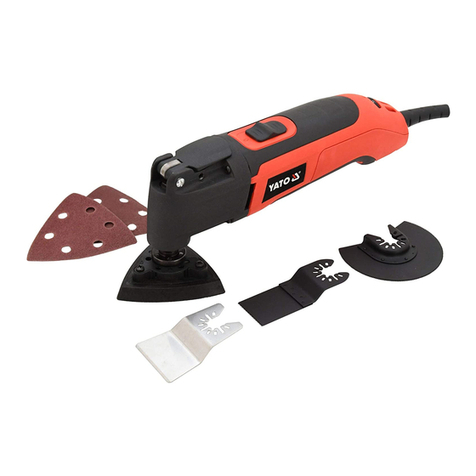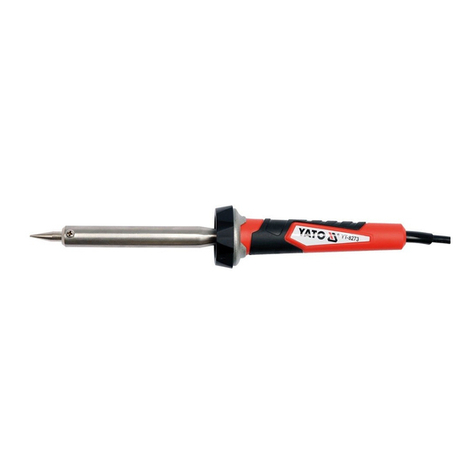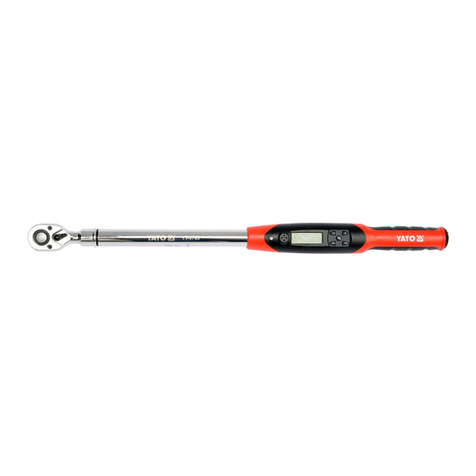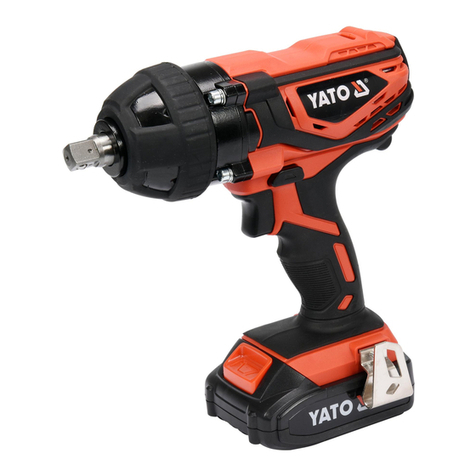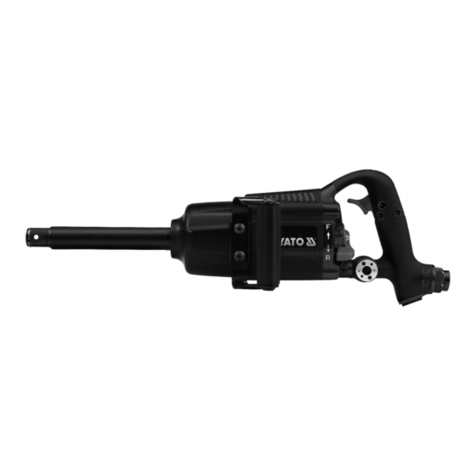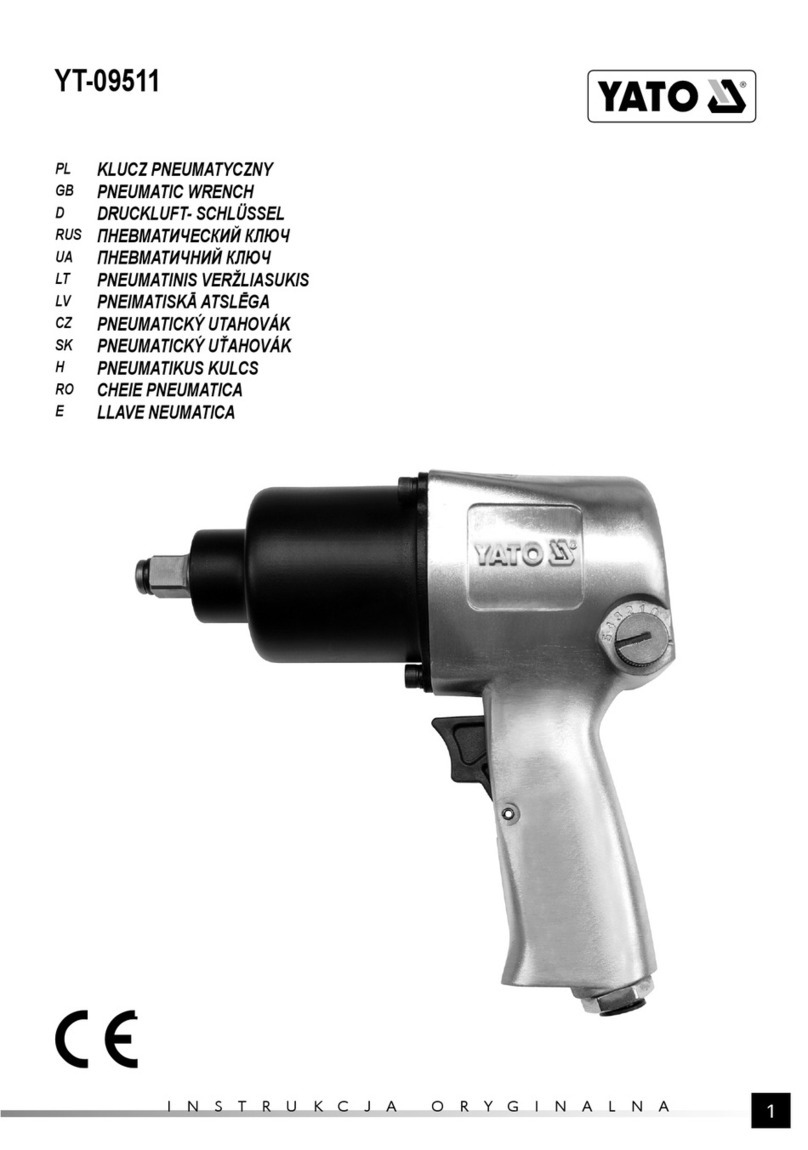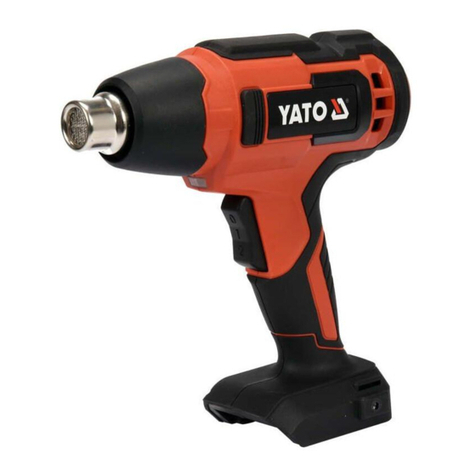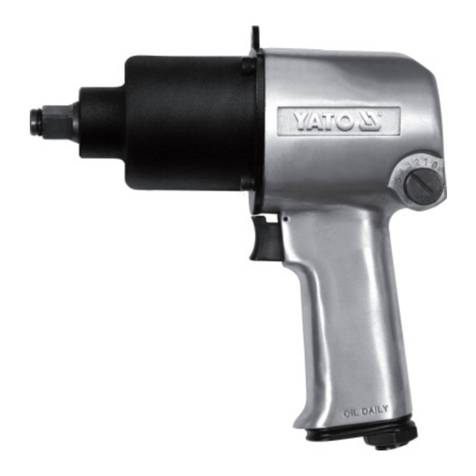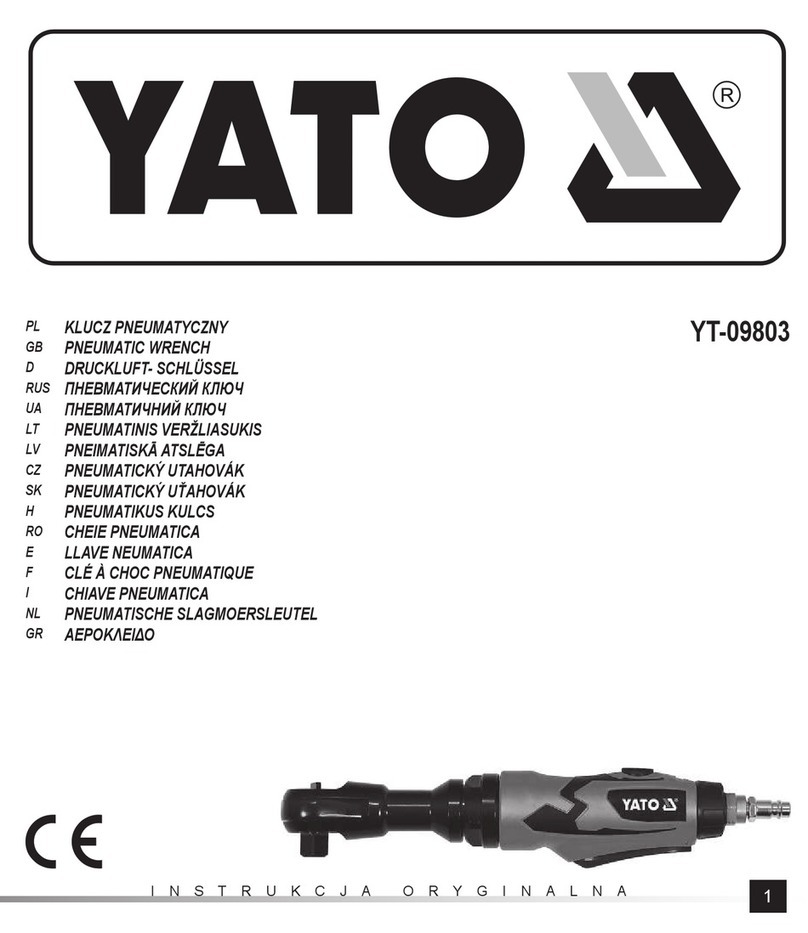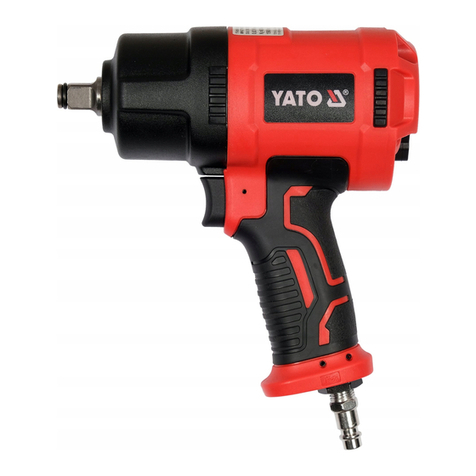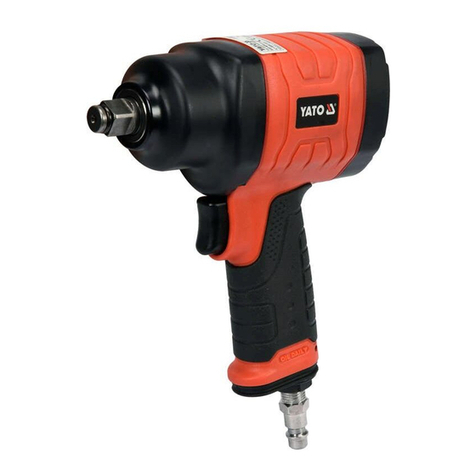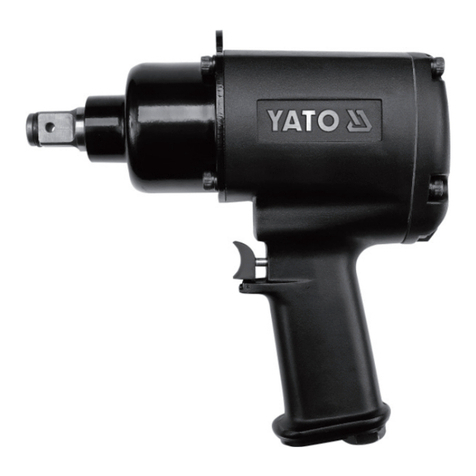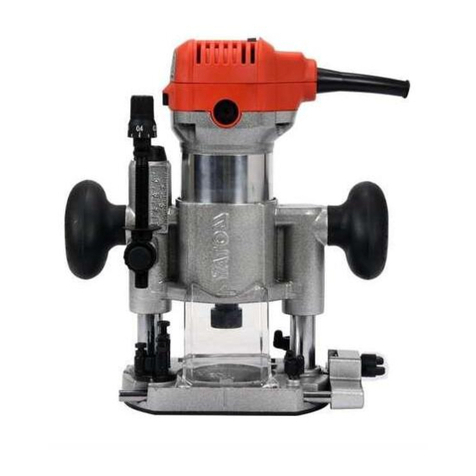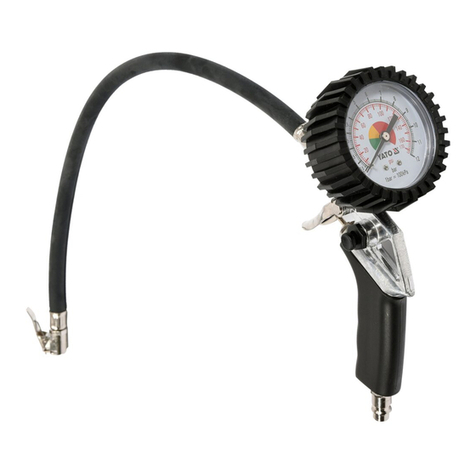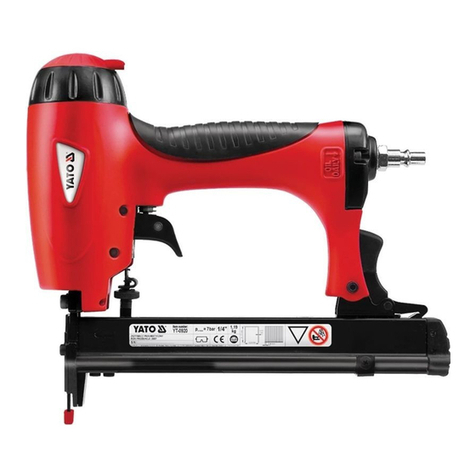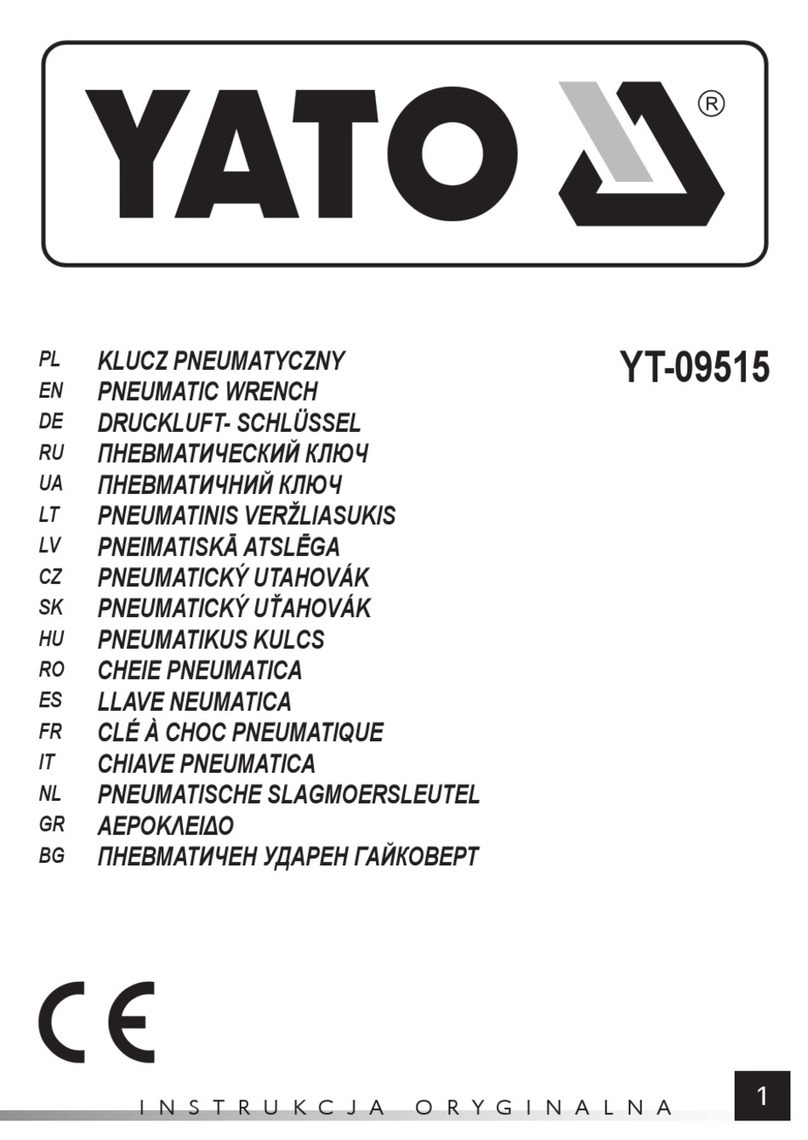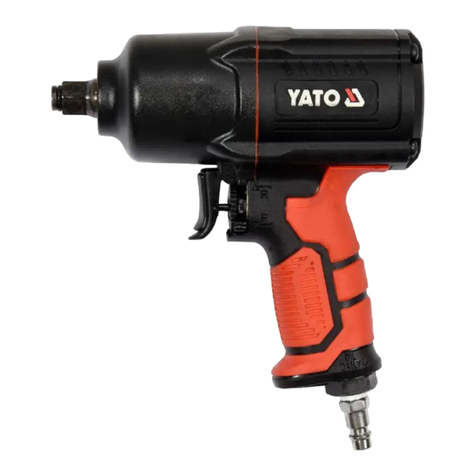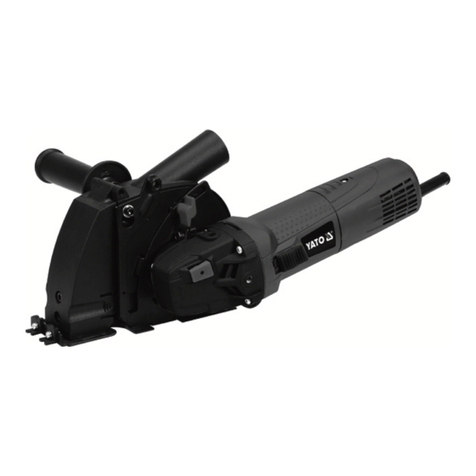YATO YT-82055 User manual

MIESZARKA DO ZAPRAW
ELECTRIC PADDLE MIXER
MÖRTELMISCHGERÄT
ЭЛЕКТРИЧЕСКАЯ МЕШАЛКА ДЛЯ МИНОМЕТОВ
БУДІВЕЛЬНИЙ МІКСЕР
SKIEDINIŲMAIŠYTUVAS
JAVAS MAISĪTĀJS
MÍCHADLO NA MALTU
MIEŠADLO NA MALTU
HABARCSKEVERŐ
MALAXOR PT. MORTAR
MEZCLADORA DE MORTERO
MÉLANGEUR A MORTIER
TRAPANO MISCELATORE
MORTELMIXER
ΑΝΑΜΙΚΤΉΡΑΣ ΚΟΝΙΆΜΑΤΟΣ
MИКСЕР ЗА СТРОИТЕЛНИ СМЕСИ
PL
EN
DE
RU
UA
LT
LV
CZ
SK
HU
RO
ES
FR
IT
NL
GR
BG
YT-82055
INSTRUKCJA ORYGINALNA 1

INSTRUKCJA ORYGINALNA
2
PL EN DE RU UA LT LV CZ SK HU RO ES FR IT NL GR BG
TOYA S.A. ul. Sołtysowicka 13-15, 51-168 Wrocław, Polska
III
III IV
V
VII
VI
VIII
2
3
45
9
7
6
8
1

INSTRUKCJA ORYGINALNA 3
PL EN DE RU UA LT LV CZ SK HU RO ES FR IT NL GR BG
1. carcasa
2. mango
3. portabrocas
4. mango adicional
5. mango trasero
6. interruptor eléctrico
7. regulador de velocidad
8. selector de sentido de rotación
9. bloqueo del interruptor
ES
1. πλαίσιο
2. λαβή
3. τσοκ τρυπάνου
4. πρόσθετη λαβή
5. οπίσθια λαβή
6. ηλεκτρικός διακόπτης
7. ρύθμιση περιστροφών
8. διακόπτης κατεύθυνσης περιστροφής
9. ασφάλιση διακόπτη
GR
1. корпус
2. ръкохватка
3. патронник
4. допълнителна дръжка
5. задна дръжка
6. бутон за включване
7. регулиране на оборотите
8. превключвател на посоката на въртене
9. блокировка на бутона за включване
BG
1. carcasă
2. mâner
3. suport mandrină
4. mâner suplimentar
5. mâner spate
6. comutator de alimentare
7. buton de reglare a turației
8. comutator pentru sensul de rotație
9. blocare comutator electric
RO
1. behuizing
2. handvat
3. boorhouder
4. bijkomende handgreep
5. achterste handgreep
6. elektrische schakelaar
7. instellen toerental
8. draairichtingsschakelaar
9. schakelaarvergrendeling
NL
1. ház
2. markolat
3. tokmány
4. plusz fogantyú
5. hátsó fogantyú
6. elektromos kapcsológomb
7. fordulatszám beállítás
8. forgásirány változtató gomb
9. bekapcsolás reteszelő
HU
1. alloggiamento
2. impugnatura
3. portapunte
4. impugnatura supplementare
5. impugnatura posteriore
6. interruttore elettrico
7. regolatore di coppia
8. commutatore del senso di rotazione
9. blocco dell’interruttore
IT
1. plášť
2. rukoväť
3. vŕtačkové skľučovadlo
4. dodatočná rukoväť
5. zadná rukoväť
6. elektrický zapínač
7. nastavenie otáčok
8. prepínačsmeru otáčok
9. blokáda zapínača
SK
1. boîtier
2. poignée
3. mandrin porte-foret
4. poignée supplémentaire
5. poignée arrière
6. interrupteur
7. régulateur de vitesse
8. commutateur de sens de rotation
9. verrou de l’interrupteur
FR
1. korpusas
2. laikiklis
3. gręžtuvo laikiklis
4. papildoma rankena
5. galinėrankena
6. elektrinis jungiklis
7. apsisukimųreguliavimas
8. apsisukimųkrypties jungiklis
9. jungiklio blokada
LT
1. kryt
2. rukojeť
3. sklíčidlo
4. přídavná rukojeť
5. zadní rukojeť
6. elektrický vypínač
7. regulace otáček
8. přepínačsměru otáček
9. blokáda vypínače
CZ
1. korpuss
2. rokturis
3. urbjpatrona
4. papildrokturis
5. aizmugurējais rokturis
6. elektriskais slēdzis
7. griešanās ātruma regulēšana
8. griešanās virziena pārslēgs
9. slēdža bloķētājs
LV
1. корпус
2. рукоятка
3. патрон свердла
4. додаткова рукоятка
5. задня рукоятка
6. електричний вмикач
7. регулювання обертів
8. перемикач напрямку обертів
9. блокування вимикача
UA
1. корпус
2. рукоятка
3. сверлильный патрон
4. дополнительная рукоятка
5. задняя рукоятка
6. электрический включатель
7. регулировка скорости вращения
8. переключатель направления вращения
9. блокировка включателя
RU
1. Gehäuse
2. Haltegriff
3. Bohrfutter
4. Zusatzhandgriff
5. Hinterer Griff
6. Elektroschalter
7. Drehzahlregler
8. Drehrichtungsschalter
9. Schaltersperre
DE
1. housing
2. handle
3. drill chuck
4. additional handle
5. rear handle
6. electric power switch
7. rotational speed control
8. rotation direction switch
9. power switch lock
ENPL
1. obudowa
2. rękojeść
3. uchwyt wiertarski
4. rękojeść dodatkowa
5. rękojeść tylna
6. włącznik elektryczny
7. regulacja obrotów
8. przełącznik kierunku obrotów
9. blokada włącznika
X
IX

INSTRUKCJA ORYGINALNA
4
PL EN DE RU UA LT LV CZ SK HU RO ES FR IT NL GR BG
Stosowaćochronędróg oddechowych
Use the respiration protection
Atemwege schützen!
Применять защиту дыхательных путей
Користуйтеся захистом дихальних шляхів
Taikyti kvėpavimo takųapsaugą
Lietojiet elpošanas traktu aizsardzību
Používejte prostředky na ochranu dýchacích cest
Používajte prostriedky na ochranu dýchacích ciest
Használjon légzésvédőálarcot
Utilizaţi apărători ale căilor respiratorii
Proteja las vías respiratorias
Utilisez la protection respiratoire
Utilizzare la protezione della respirazione
Gebruik de ademhalingsbescherming
Χρησιμοποιήστε την προστασία της αναπνοής
Използвайте респираторна защита
Stosowaćrękawice ochronne
Use protective gloves
Schutzhandschuhe verwenden
Необходимо пользоваться защитными перчатками
Слід користуватися захисними рукавицями
Vartoti apsaugines pirštines
Lietot aizsardzības cimdus
Používejte ochranné rukavice
Používajte ochranné rukavice
Használjon védőkesztyűt
Utilizarea mănuşilor de protrcţie
Use guantes de protección
Portez des gants de protection
Utilizzare i guanti di protezione
Gebruik beschermende handschoenen
Φορέστε τα γάντια προστασίας
Използвайте защитни ръкавици
Przeczytaćinstrukcję
Read the operating instruction
Bedienungsanleitung durchgelesen
Прочитать инструкцию
Прочитать iнструкцiю
Perskaityti instrukciją
Jālasa instrukciju
Přečtet návod k použití
Prečítaťnávod k obsluhe
Olvasni utasítást
Citeşti instrucţunile
Lea la instrucción
Lisez la notice d’utilisation
Leggere il manuale d’uso
Lees de instructies
Διαβάστε τις οδηγίες χρήσης
Прочетете ръководството
Używaj gogle ochronne
Wear protective goggles
Schutzbrille verwenden
Пользоваться защитными очками
Користуйтесь захисними окулярами
Vartok apsauginius akinius
Jālieto drošības brilles
Používej ochranné brýle
Používaj ochranné okuliare
Használjon védőszemüveget!
Intrebuinţeazăochelari de protejare
Use protectores del oído
Portez des lunettes de protection
Utilizzare gli occhiali di protezione
Draag een veiligheidsbril
Χρησιμοποιήστε τα γυαλιά προστασίας
Използвайте защитни очила
Ten symbol informuje o zakazie umieszczania zużytego sprzętu elektrycznego i elektronicznego (w tym baterii i akumulatorów) łącznie z innymi odpadami. Zużyty sprzęt
powinien byćzbierany selektywnie i przekazany do punktu zbierania w celu zapewnienia jego recyklingu i odzysku, aby ograniczaćilość odpadów oraz zmniejszyćstopnień
wykorzystania zasobów naturalnych. Niekontrolowane uwalnianie składników niebezpiecznych zawartych w sprzęcie elektrycznym i elektronicznym może stanowićzagroże-
nie dla zdrowia ludzkiego oraz powodowaćnegatywne zmiany w środowisku naturalnym. Gospodarstwo domowe pełni ważnąrolęw przyczynianiu siędo ponownego użycia
i odzysku, w tym recyklingu zużytego sprzętu. Więcej informacji o właściwych metodach recyklingu można uzyskaću władz lokalnych lub sprzedawcy.
Dieses Symbol weist darauf hin, dass Elektro- und Elektronik-Altgeräte (einschließlich Batterien und Akkumulatoren) nicht zusammen mit anderen Abfällen entsorgt werden
dürfen. Altgeräte sollten getrennt gesammelt und bei einer Sammelstelle abgegeben werden, um deren Recycling und Verwertung zu gewährleisten und so die Abfallmenge
und die Nutzung natürlicher Ressourcen zu reduzieren. Die unkontrollierte Freisetzung gefährlicher Stoffe, die in Elektro- und Elektronikgeräten enthalten sind, kann eine
Gefahr für die menschliche Gesundheit darstellen und negative Auswirkungen auf die Umwelt haben. Der Haushalt spielt eine wichtige Rolle bei der Wiederverwendung
und Verwertung, einschließlich des Recyclings von Altgeräten. Weitere Informationen zu den geeigneten Recyclingverfahren erhalten Sie bei den örtlichen Behörden oder
Ihrem Händler.
Этот символ информирует озапрете помещать изношенное электрическое иэлектронное оборудование (втом числе батареи иаккумуляторы) вместе сдругими
отходами. Изношенное оборудование должно собираться селективно ипередаваться вточку сбора, чтобы обеспечить его переработку иутилизацию, для
того, чтобы ограничить количество отходов, иуменьшить использование природных ресурсов. Неконтролируемый выброс опасных веществ, содержащихся в
электрическом иэлектронном оборудовании, может представлять угрозу для здоровья человека, иприводить кнегативным изменениям вокружающей среде.
Домашнее хозяйство играет важную роль при повторном использовании иутилизации, втом числе, утилизации изношенного оборудования. Подробную
информацию оправильных методах утилизации можно получить уместных властей или упродавца.
This symbol indicates that waste electrical and electronic equipment (including batteries and storage cells) cannot be disposed of with other types of waste. Waste equipment
should be collected and handed over separately to a collection point for recycling and recovery, in order to reduce the amount of waste and the use of natural resources. Un-
controlled release of hazardous components contained in electrical and electronic equipment may pose a risk to human health and have adverse effects for the environment.
The household plays an important role in contributing to reuse and recovery, including recycling of waste equipment. For more information about the appropriate recycling
methods, contact your local authority or retailer.
Цей символ повідомляє про заборону розміщення відходів електричного та електронного обладнання (втому числі акумуляторів), утому числі зіншими
відходами. Відпрацьоване обладнання повинно бути вибірково зібрано іпередано впункт збору для забезпечення його переробки івідновлення, щоб зменшити
кількість відходів ізменшити ступінь використання природних ресурсів. Неконтрольоване вивільнення небезпечних компонентів, що містяться велектричному та
електронному обладнанні, може представляти небезпеку для здоров’ялюдини івикликати негативні зміни внавколишньому середовищі. Господарство відіграє
важливу роль урозвитку повторного використання та відновлення, включаючи утилізацію використаного обладнання. Більш детальну інформацію про правильні
методи утилізації можна отримати умісцевої влади або продавця.

INSTRUKCJA ORYGINALNA 5
PL EN DE RU UA LT LV CZ SK HU RO ES FR IT NL GR BG
Šis simbolis rodo, kad draudžiama išmesti panaudotąelektrinęir elektroninęįrangą(įskaitant baterijas ir akumuliatorius) kartu su kitomis atliekomis. Naudota įranga turėtų
būti renkama atskirai ir siunčiama įsurinkimo punktą, kad būtųužtikrintas jos perdirbimas ir utilizavimas, siekiant sumažinti atliekas ir sumažinti gamtos ištekliųnaudojimą.
Nekontroliuojamas pavojingųkomponentų, esančiųelektros ir elektroninėje įrangoje, išsiskyrimas gali kelti pavojųžmoniųsveikatai ir sukelti neigiamus natūralios aplinkos
pokyčius. Namųūkis vaidina svarbųvaidmenįprisidedant prie pakartotinio įrenginiųnaudojimo ir utilizavimo, įskaitant perdirbimą. Norėdami gauti daugiau informacijos apie
tinkamus perdirbimo būdus, susisiekite su savo vietos valdžios institucijomis ar pardavėju.
Šīs simbols informēpar aizliegumu izmest elektrisko un elektronisko iekārtu atkritumus (tostarp baterijas un akumulatorus) kopāar citiem atkritumiem. Nolietotas iekārtas ir
jāsavāc atsevišķi un jānodod savākšanas punktāar mērķi nodrošināt atkritumu otrreizējo pārstrādi un reģenerāciju, lai ierobežotu to apjomu un samazinātu dabas resursu
izmantošanas līmeni. Elektriskajās un elektroniskajās iekārtās ietverto bīstamo sastāvdaļu nekontrolēta izdalīšanās var radīt cilvēku veselības apdraudējumu un izraisīt
negatīvas izmaiņas apkārtējāvidē. Mājsaimniecība pilda svarīgu lomu otrreizējās izmantošanas un reģenerācijas, tostarp nolietoto iekārtu pārstrādes veicināšanā. Vairāk
informācijas par atbilstošām otrreizējās pārstrādes metodēm var saņemt pie vietējo varas iestāžu pārstāvjiem vai pārdevēja.
Tento symbol informuje, že je zakázáno likvidovat použité elektrické a elektronické zařízení (včetněbaterií a akumulátorů) společněs jiným odpadem. Použité zařízení by
mělo být shromažďováno selektivněa odesíláno na sběrné místo, aby byla zajištěna jeho recyklace a využití, aby se snížilo množství odpadu a snížil stupeňvyužívání
přírodních zdrojů. Nekontrolované uvolňování nebezpečných složek obsažených v elektrických a elektronických zařízeních může představovat hrozbu pro lidské zdraví a
způsobit negativní změny v přírodním prostředí. Domácnost hraje důležitou roli při přispívání k opětovnému použití a využití, včetněrecyklace použitého zařízení. Další
informace o vhodných způsobech recyklace Vám poskytne místní úřad nebo prodejce.
Tento symbol informuje o zákaze vyhadzovania opotrebovaných elektrických a elektronických zariadení (vrátane batérií a akumulátorov) do komunálneho (netriedeného)
odpadu. Opotrebované zariadenia musia byťseparované a odovzdané do príslušných zberných miest, aby mohli byťnáležite recyklované, čím sa znižuje množstvo odpadov
a zmenšuje využívanie prírodných zdrojov. Nekontrolované uvoľňovanie nebezpečných látok, ktoré sú v elektrických a elektronických zariadeniach, môže ohrozovaťľudské
zdravie a maťnegatívny dopad na životné prostredie. Každá domácnosťmá dôležitú úlohu v procese opätovného použitia a opätovného získavania surovín, vrátane recy-
klácie, z opotrebovaných zariadení, Bližšie informácie o správnych metódach recyklácie vám poskytne miestna samospráva alebo predajca.
Ez a szimbólum arra hívja fel a figyelmet, hogy tilos az elhasznált elektromos és elektronikus készüléket (többek között elemeket és akkumulátorokat) egyéb hulladékokkal
együtt kidobni. Az elhasznált készüléket szelektíven gyűjtse és a hulladék mennyiségének, valamint a természetes erőforrások felhasználásának csökkentése érdekében
adja le a megfelelőgyűjtőpontban újrafeldolgozás és újrahasznosítás céljából. Az elektromos és elektronikus készülékben található veszélyes összetevők ellenőrizetlen
kibocsátása veszélyt jelenthet az emberi egészségre és negatív változásokat okozhat a természetes környezetben. A háztartások fontos szerepet töltenek be az elhasznált
készülék újrafeldolgozásában és újrahasznosításában. Az újrahasznosítás megfelelőmódjaival kapcsolatos további információkat a helyi hatóságoktól vagy a termék
értékesítőjétől szerezhet.
Acest simbol indicăfaptul cădeșeurile de echipamente electrice și electronice (inclusiv baterii și acumulatori) nu pot fieliminate împreunăcu alte tipuri de deșeuri. Deșeurile
de echipamente trebuie colectate și predate separat la un punct de colectare în vederea reciclării și recuperării, pentru a reduce cantitatea de deșeuri și consumul de resurse
naturale. Eliberarea necontrolatăa componentelor periculoase conținute în echipamentele electrice și electronice poate prezenta un risc pentru sănătatea oamenilor și are
efect advers asupra mediului. Gospodăriile joacăun rol important prin contribuția lor la reutilizare și recuperare, inclusiv reciclarea deșeurilor de echipamente. Pentru mai
multe informații în legăturăcu metodele de reciclare adecvate, contactați autoritățile locale sau distribuitorul dumneavoastră.
Este símbolo indica que los residuos de aparatos eléctricos y electrónicos (incluidas las pilas y acumuladores) no pueden eliminarse junto con otros residuos. Los aparatos
usados deben recogerse por separado y entregarse a un punto de recogida para garantizar su reciclado y recuperación a fin de reducir la cantidad de residuos y el uso de
los recursos naturales. La liberación incontrolada de componentes peligrosos contenidos en los aparatos eléctricos y electrónicos puede suponer un riesgo para la salud
humana y causar efectos adversos en el medio ambiente. El hogar desempeña un papel importante en la contribución a la reutilización y recuperación, incluido el reciclado
de los residuos de aparatos. Para obtener más información sobre los métodos de reciclaje adecuados, póngase en contacto con su autoridad local o distribuidor.
Αυτό το σύμβολο δείχνει ότι απαγορεύεται ηαπόρριψη χρησιμοποιημένου ηλεκτρικού και ηλεκτρονικού εξοπλισμού (συμπεριλαμβανομένων των μπαταριών και
συσσωρευτών) με άλλα απόβλητα. Οχρησιμοποιούμενος εξοπλισμός θα πρέπει να συλλέγεται επιλεκτικά και να αποστέλλεται σε σημείο συλλογής για να εξασφαλιστεί η
ανακύκλωσή του και ηανάκτησή του για τη μείωση των αποβλήτων και τη μείωση του βαθμού χρήσης των φυσικών πόρων. Ηανεξέλεγκτη απελευθέρωση επικίνδυνων
συστατικών που περιέχονται στον ηλεκτρικό και ηλεκτρονικό εξοπλισμό μπορεί να αποτελέσει απειλή για την ανθρώπινη υγεία και να προκαλέσει αρνητικές αλλαγές
στο φυσικό περιβάλλον. Το νοικοκυριό διαδραματίζει σημαντικό ρόλο στην συμβολή στην επαναχρησιμοποίηση και ανάκτηση, συμπεριλαμβανομένης της ανακύκλωσης,
χρησιμοποιημένου εξοπλισμού. Για περισσότερες πληροφορίες σχετικά με τις κατάλληλες μεθόδους ανακύκλωσης, επικοινωνήστε με τις τοπικές αρχές ήτον πωλητή.
Този символ информира, че изхвърлянето на изхабеното електрическо иелектронно оборудване (включително батерии иакумулатори) заедно сбитовите отпа-
дъци езабранено. Изхабеното оборудване трябва да се събира отделно ида се предаде впункта за събиране на такива отпадъци, за да се осигури неговото
рециклиране иоползотворяване, да се намали количеството на отпадъците ида се намали разхода на природни ресурси. Неконтролираното изпускане на опасни
съставки, съдържащи се велектрическото иелектронното оборудване, може да представлява заплаха за човешкото здраве ида причини отрицателни промени в
околната среда. Домакинството играе важна роля вприноса за повторната употреба иоползотворяването, включително рециклирането на изхабеното оборудване.
За повече информация относно правилните методи за рециклиране, моля, свържете се сместните власти или спродавача.
Ce symbole indique que les déchets d’équipements électriques et électroniques (y compris les piles et accumulateurs) ne peuvent être éliminés avec d’autres déchets.
Les équipements usagés devraient être collectés séparément et remis à un point de collecte afin d’assurer leur recyclage et leur valorisation et de réduire ainsi la quantité
de déchets et l’utilisation des ressources naturelles. La dissémination incontrôlée de composants dangereux contenus dans des équipements électriques et électroniques
peut présenter un risque pour la santé humaine et avoir des effets néfastes sur l’environnement. Le ménage joue un rôle important en contribuant à la réutilisation et à la
valorisation, y compris le recyclage des équipements usagés. Pour plus d’informations sur les méthodes de recyclage appropriées, contactez votre autorité locale ou votre
revendeur.
Dit symbool geeft aan dat afgedankte elektrische en elektronische apparatuur (inclusief batterijen en accu’s) niet samen met ander afval mag worden weggegooid. Afge-
dankte apparatuur moet gescheiden worden ingezameld en bij een inzamelpunt worden ingeleverd om te zorgen voor recycling en terugwinning, zodat de hoeveelheid afval
en het gebruik van natuurlijke hulpbronnen kan worden beperkt. Het ongecontroleerd vrijkomen van gevaarlijke componenten in elektrische en elektronische apparatuur
kan een risico vormen voor de menselijke gezondheid en schadelijke gevolgen hebben voor het milieu. Het huishouden speelt een belangrijke rol bij het bijdragen aan
hergebruik en terugwinning, inclusief recycling van afgedankte apparatuur. Voor meer informatie over de juiste recyclingmethoden kunt u contact opnemen met uw gemeente
of detailhandelaar.
Questo simbolo indica che l’apparecchiatura elettrica e elettronica usurata (comprese le batterie e gli accumulatori) non può essere smaltita insieme con altri rifiuti. Le appa-
recchiature usurate devono essere raccolte separatamente e consegnate al punto di raccolta specializzato per garantire il riciclaggio e il recupero, al fine di ridurre la quantità
di rifiuti e diminuire l’uso delle risorse naturali. Il rilascio incontrollato dei componenti pericolosi contenuti nelle apparecchiature elettriche e elettroniche può costituire il rischio
per la salute umana e causare gli effetti negativi sull’ambiente naturale. Il nucleo familiare svolge il ruolo importante nel contribuire al riutilizzo e al recupero, compreso il
riciclaggio dell’apparecchiatura usurata. Per ottenere le ulteriori informazioni sui metodi di riciclaggio appropriate, contattare l’autorità locale o il rivenditore.
Table of contents
Languages:
Other YATO Power Tools manuals
